CityTouring
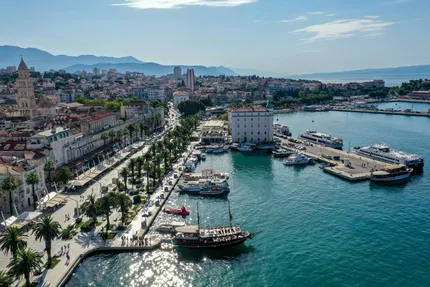
City trip to Split
CroatiaSplit layers a lively Adriatic port over a 1,700-year-old Roman palace. Croatia's second city is built inside and around Diocletian's Palace, a UNESCO site where narrow lanes, stone courtyards, and lived-in apartments sit beside temples, churches, and cafes. The marble Riva promenade fronts the harbor with palms, terraces, and sea views to the islands. Climb the bell tower of the Cathedral of Saint Domnius for a skyline panorama, or head to Marjan Hill's pine forest for beaches, viewpoints, and quiet chapels.
Swimming is easy at sandy, shallow Bacvice, while Kasjuni and Znjan offer clear pebble coves. Culture is compact: the Archaeological Museum tracks Dalmatia's past; the Mestrovic Gallery shows Croatia's famed sculptor; markets like Pazar and the fish market anchor daily life. Ferries fan out to Hvar, Brac, and Vis, making Split a natural base for island day trips. Evenings hum with wine bars tucked inside Roman cellars and people watching along the Riva. The city blends history, sea, and a relaxed Mediterranean rhythm, with most sights walkable and the atmosphere welcoming year-round.
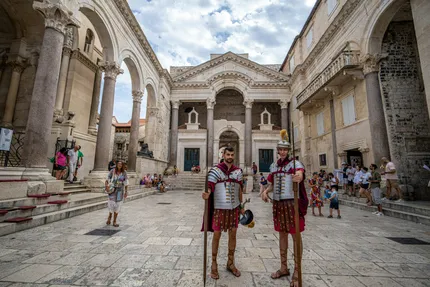
Diocletian’s Palace
UNESCO-listed Roman palace built circa AD 305 that evolved into Split’s old town. Wander labyrinthine alleys, the Peristyle, and atmospheric cellars, where shops and cafes mingle with ancient walls. Temples, gates, and courtyards reveal layered history, while residents still live within the complex, creating a rare, living archaeological site. Popular Game of Thrones filming locations appear throughout.
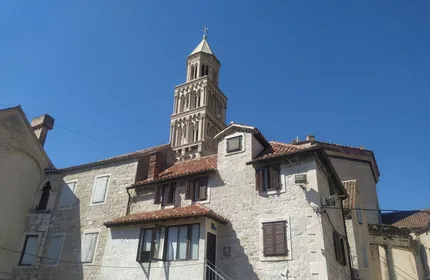
Cathedral of Saint Domnius & Bell Tower
Among the world’s oldest cathedrals still in use, Saint Domnius occupies Diocletian’s former mausoleum. Admire remarkable Romanesque and Gothic details, treasury artifacts, and the octagonal interior. Climb the slender bell tower for sweeping views over the palace, harbor, and Marjan. The juxtaposition of pagan origins and Christian devotion embodies Split’s layered heritage.
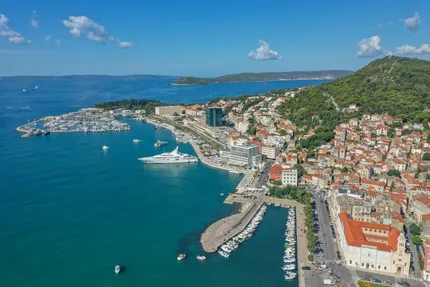
Marjan Hill Park Forest
Split’s green lung, this pine-covered hill and park forest offers trails, viewpoints, and hidden chapels. Hike or cycle to Telegrin peak, pause at Vidilica terrace, and descend to beaches like Kašjuni and Bene. Hermitage caves, scenic stone stairways, and sunsets over the islands make Marjan ideal for active sightseeing close to town.
Split suits travelers who want substantial history without leaving the coast. Roman and medieval enthusiasts can base themselves inside Diocletian's Palace, tour the Peristyle and cathedral, visit the City Museum and the Archaeological Museum, then compare late antique stonework with Venetian-era details in Veli Varos and along the Riva. Active visitors can run or cycle the shaded paths of Marjan, rent a kayak or SUP below the hill, or swim laps off Kasjuni's buoys. Families benefit from Bacvice's shallow sand, playgrounds on the waterfront, and short walking distances; just plan for cobblestones and some steps. Food-focused travelers find seafood markets at dawn, konobas serving grilled fish and pasticada, and wine bars pouring Dalmatian varieties.
Night owls can bar-hop through the Palace alleys and dance at Bacvice clubs. Short-break planners who like day trips have easy wins: Roman Salona in Solin (15 minutes), the clifftop bastions of Klis Fortress (25 minutes), UNESCO-listed Trogir (30-40 minutes), or a fast ferry to Brac for a beach afternoon. Photographers will value bell-tower views, golden hour on Marjan, and working streets rather than stage sets. If your priority is big museums or luxury shopping, Split is modest; if you want sea air, stone, and lived-in heritage compressed into a few walkable days, it delivers. Adventure seekers can add a rafting or canyoning day on the Cetina River near Omis, reachable in under an hour.
Three top reasons for a city trip to Split
- Roam UNESCO-listed Diocletian's Palace, a living Roman fortress with Peristyle, Cathedral of Saint Domnius bell tower, subterranean cellars, hidden courtyards, cafes, and Game of Thrones sites woven into Split life.
- Savor Split's seafront: stroll palm-lined Riva, swim at sandy Bačvice, hike Marjan Hill viewpoints, then island-hop by ferry to Hvar, Brač, Šolta, or Blue Lagoon; kayak, paddleboard, and watch sunsets.
- Immerse in Split's Dalmatian culture: browse Pazar and Peskarija, dine at konobas on pašticada, peka, grilled Adriatic fish; sip Plavac Mali; enjoy klapa, visit Meštrović Gallery, cheer Hajduk at Poljud.
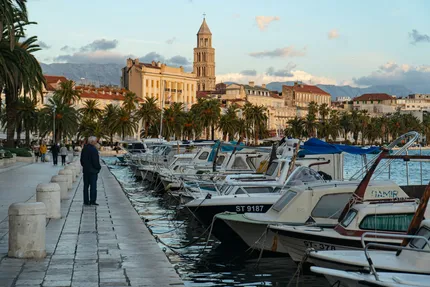
Best time to visit Split
Late spring and early autumn are the sweet spot. May and June bring sunny days around 22-27 C, wildflowers on Marjan, and warm seas by mid-June. September and early October keep the water swimmable, with fewer cruise crowds and calmer prices. July and August are festive and lively with the Split Summer Festival, but they are hot (often 30 C plus) and busy, and accommodation books far ahead. Winter is mild, museums stay open, and locals reclaim the Riva, yet some island services run on reduced schedules and bura winds can blow. For a balanced trip of swimming and sightseeing, target late May-June or September.
More activities and things to see in Split:
Riva Promenade
Split’s seafront Riva is a palm-lined promenade framed by the palace and ferries. Join locals for coffee, people‑watching, and evening passeggiata. Street performers, seasonal events, and open-air terraces create a lively atmosphere. It’s the city’s social heart and an easy starting point for boats, island trips, and exploring the old town.
Bačvice Beach and Picigin
Bačvice is Split’s central sandy beach, a short walk from the Old Town and ferry port, known for warm, shallow water. It’s the birthplace of picigin, a local game where players in waist‑deep water acrobatically keep a small ball from touching the sea. Facilities include cafes, showers, rentals, and lively nightlife nearby.
Ivan Meštrović Gallery and Kaštelet
Explore Croatia’s foremost sculptor at his seaside villa-museum, displaying powerful works in marble, bronze, and wood. The sculpture park and Mediterranean gardens add serenity. Nearby, Kaštelet Crikvine chapel houses Meštrović’s magnificent wooden reliefs. Combined tickets, quiet settings, and coastal views make this a rewarding art and architecture visit beyond the old town.
Klis Fortress
Perched above Split, Klis is a medieval fortress with commanding views over the city, mountains, and islands. Explore ramparts, gates, and a small museum detailing battles with Ottomans and Venetians. Recognizable as Meereen in Game of Thrones, it pairs well with nearby ancient Salona, making a focused half‑day history excursion.
Archaeological Museum Split
Croatia’s oldest museum presents artifacts from nearby Roman Salona and Dalmatia: sculptures, inscriptions, glass, coins, and early Christian sarcophagi. Quiet galleries and a pleasant lapidarium garden allow close viewing of details. It’s an excellent contextual stop before or after the palace, illuminating Split’s origins and regional history across classical and medieval periods.
Green Market (Pazar) and Fish Market
Experience everyday Split at the lively Green Market beside the palace, piled with seasonal produce, cheeses, cured meats, and local honey. Continue to the Fish Market, where morning catches are sold quickly. Sample snacks, practice a few Croatian phrases, and feel the city’s rhythm before diving back into sightseeing or the waterfront.
Ferry hop to nearby islands
Split’s harbor is a gateway to Brac, Hvar, Solta, and Vis. Take a day trip for beaches, vineyards, or historic towns, using frequent ferries or organized speedboat tours. Popular choices include Zlatni Rat at Bol and Hvar Town. Check schedules, reserve in summer, and start early to maximize time ashore.
Varoš and Matejuška
Discover Split’s fishermen’s quarter beneath Marjan: narrow lanes, stone houses, and casual konobas serving grilled seafood. Stroll from Matejuška harbor up through Varoš to viewpoints, churches, and street art. It’s atmospheric, less crowded than the palace core, and ideal for sunset photos or a simple, traditional meal after sightseeing, with nearby bars.
Getting around in Split
Split’s historic core—Diocletian’s Palace, the Riva, and Veli Varoš—is compact and best explored on foot. Surfaces are mostly stone and can be slick when wet; there are stairs and narrow lanes. Promet Split runs an extensive bus network covering suburbs, beaches (Bačvice, Žnjan), and Marjan area; services are frequent on main routes, thinning late at night. Buy tickets at kiosks or from drivers (slightly more), with zone-based fares. Taxis and ride-hailing apps (Uber, Bolt) are widely available and reasonably priced for cross-town trips, useful after 23:00. Cycling is feasible on waterfront promenades and some marked lanes, though traffic can be dense; bike and e-scooter rentals are common. Parking in and near the Old Town is scarce and expensive, especially in summer; many hotels lack on-site parking. A car is unnecessary in the center but helpful for day trips to Trogir, Klis, Omiš, or Krka National Park. Ferries and fast catamarans from the main port make easy day trips to Brač, Hvar, Šolta, and Vis.
Getting to Split
Split Airport (SPU) sits about 25 km west of the center near Trogir, with frequent seasonal and year-round flights. Direct links connect Split to major European hubs such as Frankfurt, Munich, Vienna, Zurich, Amsterdam, Paris, London, and Rome, plus many low-cost routes in summer (e.g., Ryanair, easyJet, Wizz Air, Eurowings). From SPU, a dedicated shuttle bus runs to Split’s main bus station by the ferry port; local bus 37 also serves the airport, and taxis or ride-hailing take 30–45 minutes depending on traffic. By rail, Split’s terminus is beside the port; daily HŽPP trains connect with Zagreb for onward national and international rail. In season, additional through services may operate, but buses are faster and more frequent. Long-distance coaches (Arriva, FlixBus and others) link Split with Zagreb, Zadar, Dubrovnik, Šibenik, Mostar, Sarajevo, Ljubljana, Trieste, Venice, Budapest, Vienna, and Munich. The Port of Split has year-round overnight ferries to Ancona (Italy) and frequent domestic ferries/catamarans to Brač, Hvar, Vis, Šolta, Korčula, and more.